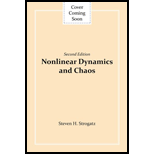
Interpretation:
The integral
Concept Introduction:
Poincare map is defined by
Answer to Problem 1E
Solution:
The integral
Explanation of Solution
Let
Then, according to the definition of the Poincare map
Where
Using partial fraction method, we can write the integral as
Comparing the coefficients gives:
Put
Add
Put this value in the equation
Hence,
Insert it in the integral
Using logarithmic identity, the above equation can be written as
Since
Rearrange it as
Divide numerator and denominator of the right-hand side expression by
Take the square root of both sides
Hence,
According to the definition of the Poincare map,
Hence,
Differentiate it with respect to r
Put
Hence,
A Poincare function can be written using a Poincare map definition and partial fractions method.
Want to see more full solutions like this?
Chapter 8 Solutions
Nonlinear Dynamics and Chaos
- For an element x of an ordered integral domain D, the absolute value | x | is defined by | x |={ xifx0xif0x Prove that | x |=| x | for all xD. Prove that | x |x| x | for all xD. Prove that | xy |=| x || y | for all x,yD. Prove that | x+y || x |+| y | for all x,yD. Prove that | | x || y | || xy | for all x,yD.arrow_forward31. Prove statement of Theorem : for all integers and .arrow_forwardLet be as described in the proof of Theorem. Give a specific example of a positive element of .arrow_forward
- Let D be an integral domain with four elements, D=0,e,a,b, where e is the unity. a. Prove that D has characteristic 2. b. Construct an addition table for D.arrow_forwardIf x and y are elements of an ordered integral domain D, prove the following inequalities. a. x22xy+y20 b. x2+y2xy c. x2+y2xyarrow_forwardLet f(x),g(x),h(x)F[x] where f(x) and g(x) are relatively prime. If h(x)f(x), prove that h(x) and g(x) are relatively prime.arrow_forward
- 6. Prove that if is any element of an ordered integral domain then there exists an element such that . (Thus has no greatest element, and no finite integral domain can be an ordered integral domain.)arrow_forward2. Prove the following statements for arbitrary elements of an ordered integral domain . a. If and then . b. If and then . c. If then . d. If in then for every positive integer . e. If and then . f. If and then .arrow_forward
 Algebra for College StudentsAlgebraISBN:9781285195780Author:Jerome E. Kaufmann, Karen L. SchwittersPublisher:Cengage Learning
Algebra for College StudentsAlgebraISBN:9781285195780Author:Jerome E. Kaufmann, Karen L. SchwittersPublisher:Cengage Learning Elements Of Modern AlgebraAlgebraISBN:9781285463230Author:Gilbert, Linda, JimmiePublisher:Cengage Learning,
Elements Of Modern AlgebraAlgebraISBN:9781285463230Author:Gilbert, Linda, JimmiePublisher:Cengage Learning, Linear Algebra: A Modern IntroductionAlgebraISBN:9781285463247Author:David PoolePublisher:Cengage Learning
Linear Algebra: A Modern IntroductionAlgebraISBN:9781285463247Author:David PoolePublisher:Cengage Learning- Algebra & Trigonometry with Analytic GeometryAlgebraISBN:9781133382119Author:SwokowskiPublisher:Cengage



